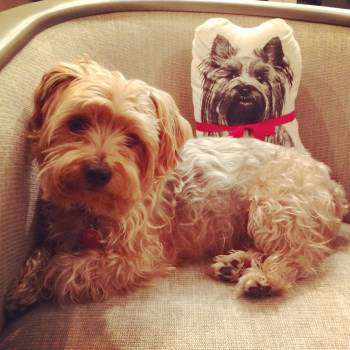The Colors of Yorkshire Terriers
Overview
The Yorkshire Terrier, affectionately known as the Yorkie, is a breed renowned not just for its vibrant personality but also for its distinctive, luxurious coat. This article covers the breed standards across the globe in regard to Yorkshire Terrier coat color, highlighting the American Kennel Club's (AKC) standard and non-standard colors, including color codes, and explores the fascinating transformation of coat color from puppyhood to adulthood. We also dive into rare colors that are sometimes seen with this breed.
Basic Yorkshire Terrier Color Facts
Yorkshire Terriers undergo a fascinating color transformation from puppyhood to adulthood. Initially, puppies display a black and tan coat, which gradually shifts to a blue and tan coloring as they mature. The 'blue' in adult Yorkshire Terriers is essentially a diluted, lighter form of black. Additionally, the 'tan' in some dogs may deepen into what is referred to as 'gold.' These basic color changes are just the beginning. This article delves deeper into the nuances of these transformations, exploring the genetics behind coat color, the range of color variations, and other intriguing aspects of Yorkshire Terrier coloring.
Photo above: A Yorkshire Terrier puppy with classic black and tan coloring.
Photo above: An adult Yorkshire Terrier with classic blue and tan coloring.
Yorkshire Terrier Color Per Breed Standards
Yorkshire Terriers are celebrated worldwide for their striking appearance, characterized by a glossy, fine, and silky coat. Globally, there is a consensus about the desirable colors.
Traditionally, a Yorkshire Terrier puppy is black and tan. And a Yorkshire Terrier adult dog is blue and tan. But, gold (a richer, deeper tan) is another option, seen with either black or blue.
The AKC accepted colors (with our explanations) are:
Black and Tan (Color code 018): Common in puppies, this coloration often transitions as the dog matures.
Black and Gold (Color code 041): Similar to black and tan, with gold replacing the tan areas as the dog matures.
Blue & Tan (Code 044): This is the classic coloration of adults, with the distinct separation of blue on the body and tail, and tan on the head, chest, and legs.
Blue & Gold (Color code 041): In this variation, the tan is replaced or appears more as gold, especially visible on the head, chest, and legs.
Markings:
Many Yorkshire Terriers have no markings at all. But technically in AKC conformation events they are allowed to have a small white marking on the chest no larger than 1 inch at its longest dimension.
Color Explanations
Blue: This color is only seen with adult Yorkshire Terriers once the color transformation from black to blue is complete. Blue is a diluted black. It ranges from a lighter silvery shade to a dark steel blue. It is the dark steel blue that is expected in conformation shows.
Black: The black color in Yorkshire Terriers is characterized by its deep, intense hue that offers a striking contrast to tan or gold. This color is most prominent in puppies and is generally expected to be solid and uniform, covering most of the pup’s body.
Tan: The tan color seen with Yorkshire Terriers is often richer at the roots and lighter at the tips. With adults, it usually appears around the muzzle, ears, legs, and chest. The clarity and brightness of the tan are highly prized.
Gold: Gold in Yorkshire Terriers is a luxurious shade that is darker than tan. It ranges from a deep, rich gold to a lighter, more vibrant hue. It is found in similar areas as tan (around the muzzle, ears, legs, and chest) but is distinguished by its brighter, more lustrous quality. In adult dogs, the gold may replace the tan seen in puppies, creating a beautiful contrast with the blue. The brilliance and saturation of the gold color are considered desirable traits, adding to the breed's aesthetic appeal.
Non-Standard Colors of the Yorkshire Terrier
There are a couple non-standard colors, while not recognized for show purposes, that may be seen with Yorkshire Terriers. While these Yorkies can be registered with the AKC, the coat colors are a disqualification in the conformation show ring.
Fully Tan Yorkies:
Bear, a Yorkshire Terrier with a fully tan coat; photo courtesy of Alexandra G.
Rare, but possible, are Yorkshire Terriers that hold very little to no black or blue. These Yorkshire Terriers may be majorly or fully tan, cream or gold. In some cases, these may be dubbed ‘golddust’ Yorkshire Terriers, which are not an official variety of the breed.
Red-Legged Yorkshire Terriers:

This Yorkshire Terrier, affectionately named Yorkie and pictured here at the age of 3,
has been confirmed through DNA testing by his owner to be a purebred.
Despite this, he displays a highly unusual coat color.
This unique pattern is known as "red-legged".
Photo courtesy of Pamela R.
These unique red-legged Yorkshire Terriers will have several elements that set them apart from most. The black does not change to blue, there will be no tan, and instead the secondary color will be a vibrant red. Coat texture may not be as straight and silky as is expected, and the coat may not be able to grow long. This coloring does not meet the breed standard.
The Color Transformation Journey: Color Changes from Puppy to Adult for Yorkshire Terriers
One of the most enchanting aspects of Yorkie ownership is witnessing the color transformation from puppyhood to adulthood, which is a change from black and tan to blue and tan (or gold). There are also accompanying changes in coat texture. Let’s see what changes take place.
Puppy Coat:
Initially, Yorkie puppies are adorned with a black and tan coat, significantly darker and softer than what is observed in adults. Black is the dominant color in their early days, with tan accents in relatively small areas. The puppy coat is known for its softness and fluffiness, offering a gentle texture that is markedly different from the sleek, fine texture of the adult coat. As the puppy grows, the expansive black areas gradually recede, making way for an increased presence of tan, particularly across the back and flanks.
Color and Texture Transformation:
The transition from black to blue (a diluted form of black) is not merely a color shift but is also accompanied by a change in coat texture. As the Yorkie matures and the black transforms into blue, the coat begins to develop its signature silkiness and straightness, characteristic of the adult Yorkie. This shift towards a blue and tan (or blue and gold) coat marks the arrival of the adult phase, with the tan areas possibly brightening to a more vivid gold. This developmental phase, starting around six months and completing between the 2-year and 3-year marks, signifies not just a change in hue but also an evolution from the softer, fluffier puppy coat to the glossy, fine-textured adult coat.
Adult Coat:
Upon completion of the color transformation, the adult Yorkshire Terrier showcases a coat that is not only remarkable for its blue and tan (or blue and gold) colors but also for its fine, silky texture. This texture is a hallmark of the breed, with the blue areas displaying a soft, lustrous sheen and the tan or gold areas adding contrast with their brighter, yet equally silky quality. The adult coat's sleekness and straightness are the results of both genetic factors and proper grooming, varying from one dog to another but always reflecting the breed's distinctive elegance.
Color Genetics: How Black Turns to Blue
The blue color in adult Yorkshire Terriers is a defining characteristic of the breed. While there are a few other terriers that have blue, including the Australian Terrier, Bedlington Terrier and Kerry Blue Terrier, each breed expresses this coloration in a unique way that contributes to their own breed-specific charm and appeal.
Understanding how black in Yorkshire Terrier puppies turns to blue in Yorkshire Terrier adults involves a foray into canine genetics, specifically the genes that affect coat color. Let’s dive in.
Genetic Basis of Blue Coloration:
The transformation of black to blue in a Yorkshire Terrier's coat is primarily attributed to a dilution gene, known scientifically as the Dilution (D) locus. This gene locus has two alleles (forms): one for dilution (d) and one for the non-diluted or normal color (D). The blue coloration occurs when a dog inherits two copies of the dilution allele (dd), which dilutes the black pigment (eumelanin) in the hair, resulting in the blue coat.
How Black Turns to Blue:
In the simplest terms, the process of black turning to blue in Yorkshire Terriers can be explained as a reduction in the intensity of the black pigment in the hair. When a Yorkie puppy is born, they often have a black and tan coat, which is much darker than what is seen in adult dogs.
As the puppy matures, if it carries the double dilution gene (dd), the black areas of the coat start to lighten, transitioning through various shades until they achieve the characteristic blue. This change typically begins around six months of age but can continue until the dog is around two to three years old.
The Role of Melanin:
Melanin is the pigment responsible for coloring the coat of dogs, and it comes in two forms: eumelanin (black or brown pigment) and phaeomelanin (red or yellow pigment). The Dilution gene affects eumelanin (black), spreading the pigment granules in the hair shaft more thinly and causing the coat to appear lighter or more grayish than solid black. This dilution effect is what gives the Yorkie its blue coloration.
Genetic Complexity:
It's important to note that the genetic underpinnings of coat color in dogs, including Yorkshire Terriers, are complex and involve multiple genes beyond just the Dilution locus. For instance, the interaction between the Dilution gene and other genetic factors can influence the exact shade of blue, as well as the distribution of blue and tan colors on the dog's body.
Nose and Eye Color
The nose color, along with the eye rims, lips, and paw pads in Yorkshire Terriers, is uniformly black, creating a striking contrast with their luxurious coat colors. Interestingly, while newborn Yorkies may initially have a pink nose, it typically transitions to black within the first few days to a week of life, marking a critical developmental milestone in these pups. This change is a sign of good health and breed purity.
The eyes of a Yorkshire Terrier are captivating, typically a deep, rich brown that complements their silky coats. Breed standards often describe the ideal eye color as ‘dark,’ contributing to their alert and intelligent expression. This dark eye color enhances their appearance and reflects the breed’s spirited and energetic nature. The depth of the eye color can vary slightly, but always within shades of brown, adding to the Yorkie’s enchanting gaze.
Moreover, these color features are more than just aesthetic; they are indicative of the breed’s genetic health. A Yorkshire Terrier with the correct nose, eye rim, pad pigmentation, and characteristic dark brown eyes exemplifies the breed standard and contributes to their overall charismatic presence. These details not only distinguish the Yorkshire Terrier from other breeds but also highlight the meticulous care breeders take to preserve the breed’s unique characteristics.
Related Articles:
Dogs that Look Like Yorkies but Have White on the Coat - While purebred Yorkshire Terriers can have a small amount of white, if there is a lot of white, along with tan and black or blue, this is most like a Biewer Terrier.






